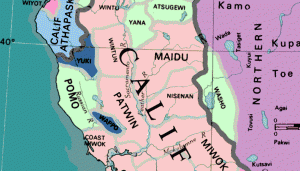The Chinook tribe occupied the area along the Columbia River from it’s mouth all the way up to The Dallas area. They lived along the Willamette, Clackamas and Lewis Rivers. Their language is split into two and possibly even three distinct languages. Lower Chinook which is spoken around the mouth of the Columbia is split into two dialects. Both dialects are unintelligible to any other Chinook dialects.
Native Americans in Portland Oregon
If we travel east along the Columbia River we find Kalama which is where the Kathlamet dialect was spoken. Some scholars believe to be a distinct language in itself and have classified it as Middle Chinook.
Of the Lower Chinook dialects, Multnomah was spoken around the confluence of the Willamette and Columbia rivers which included present day Sauvie Island, downtown Portland, the South Shore of the Columbia River between the Willamette and Government Island (where present day I-205 crosses the Columbia River), and all the way west to the Lewis River.
The last known dialect is Kiksht which was spoken south on the Willamette River to Willamette Falls at Oregon City, along the Clackamas River, and spoken around Cascades and all the way east to The Dallas. It’s possible that this dialect was also spoken along the Sandy River, but there is little information about the Chinook Tribe living full time in that area. It is possible that areas along the Sandy River were simply less habitable due to it’s original name given by Lewis and Clark – Quick Sand River. What is known for sure is that Indian trails crossed through the area connecting the Willamette Falls area to The Dallas area. Two of these trails were later used by white settlers and became known as Lolo Pass and Barlow Road. At the very least the Sandy River was used for seasonal gatherings of Huckleberry which would have necessitated temporary camps.

While it’s most likely the Chinooks had permanent villages, large portions of the tribes seasonally traveled throughout their range to follow food sources. While not remarked upon directly, Lewis and Clark had two different population estimates for tribes near their winter quarters. Once in winter and again in the spring. Dissenting opinions say that Lewis and Clark miscounted, or simply got more familiar with the natives in the area and made more accurate accounts the second time. This might be true if the population numbers were not so drastic, almost always doubled in every single village counted which would lend credence to the more nomadic natures of the Indians.
The Upper and Lower Chinooks had slighly different diets. The Lower Chinooks ate a lot more marine life such as whale, clams, and other seafoods due to their locations near the mouth of the Columbia River. Both ate salmon, sturgeon, deer, elk, along with wapato, camas, hazelnuts and acorns. Archaeological evidence suggests that they also ate harbor seal, dog, bobcat, racoon, turtles, varieties of fresh water fish and other small animals and of course blackberries and huckleberries.
While the Lower Chinooks were most likely visited by the Spanish as early at 1535, and would have seen Robert Gray’s Columbia Rivera enter the river in May 1792, it was not until British Royal Navy Lieutenant William Broughton sailed up the Columbia River and named Vancouver Point on October 30, 1792 that the Upper Chinook were first visited by white men. Even then it seems they were for the most part ignored, even though Chinook Canoes accompanied the Lieutenant up the river.
Small pox epidemics ravaged the Chinook by the time Lewis and Clark made their own observations. The first epidemic is reported to have happened in the 1770’s and the second in 1801. This makes it unclear as to who or where the epidemics came from. It’s possible that it was passed among the different nations, British ships sailing and trading along the coast, or French Canadian Trappers who passed it on. What was clear even to Lewis and Clark is that the native population had been drastically reduced by the time they visited.
Between Lewis and Clark’s visit, and the arrival of the Hudson Bay Company who built Fort Vancouver across the river in 1824-1825 there is little evidence of European visits to the inland tribes around the area of Portland. There had to have been visits though, Fort George (formerly Fort Astoria,) had been founded in May 1811. Located as it was at the head waters of the Columbia River, and thus in the Chinook Territory, the fur trappers and Natives traded pelts and probably even married.
The next few years probably saw drastically increased trade with the local Chinooks, especially those of the Multnomah speaking villages. By 1829 retired French Canadian trappers were definitely traveling through the area to settle further up the Willamette River at what is now called Champoeg.
1843 saw the initial inklings of the founding of Portland. William Overton and Asa Lovejoy filed a claim over an area known to locals at the time as “The Clearing.” The Clearing had been a Chinook village at one time, and there was even corn already growing. The village and tribes name are unknown to us now, but this location is right about where Burnside and 1st Street/Naito Parkway are now.
Between 1851 and 1856 settlers and Indian Agents managed to get the Chinook to (in most cases unwillingly) move to reservations. Even afterwards they were still blamed for killings and animosity towards settlers, even though it many cases it might have been the settlers fault. Today the remains of the Chinook Tribes are integrated into the Confederated Tribes of Siletz Indians.
Links:
Portland : Cultural resources protection plan for Columbia South Shore
Lewis and Clark Journals
The Chinook Indians: Traders of the Lower Columbia River (Civilization of the American Indian Series)
Siletz Indian History

